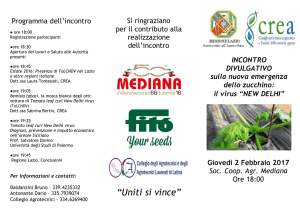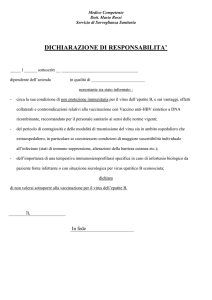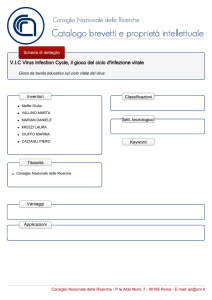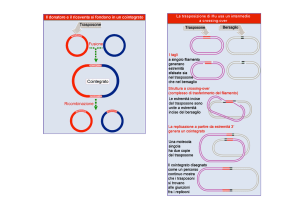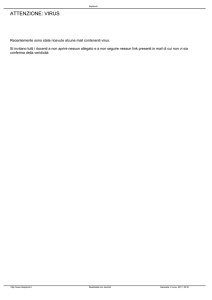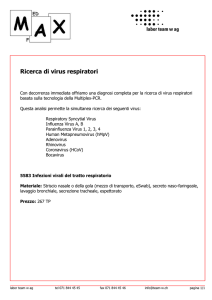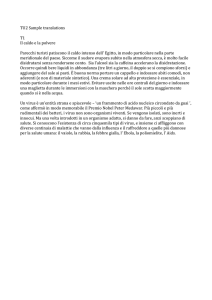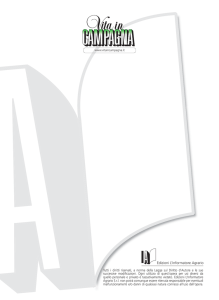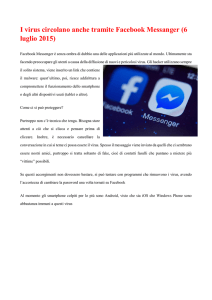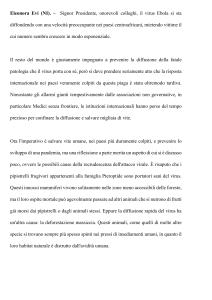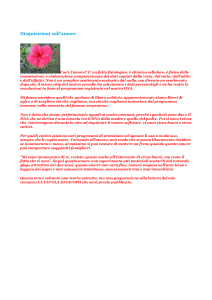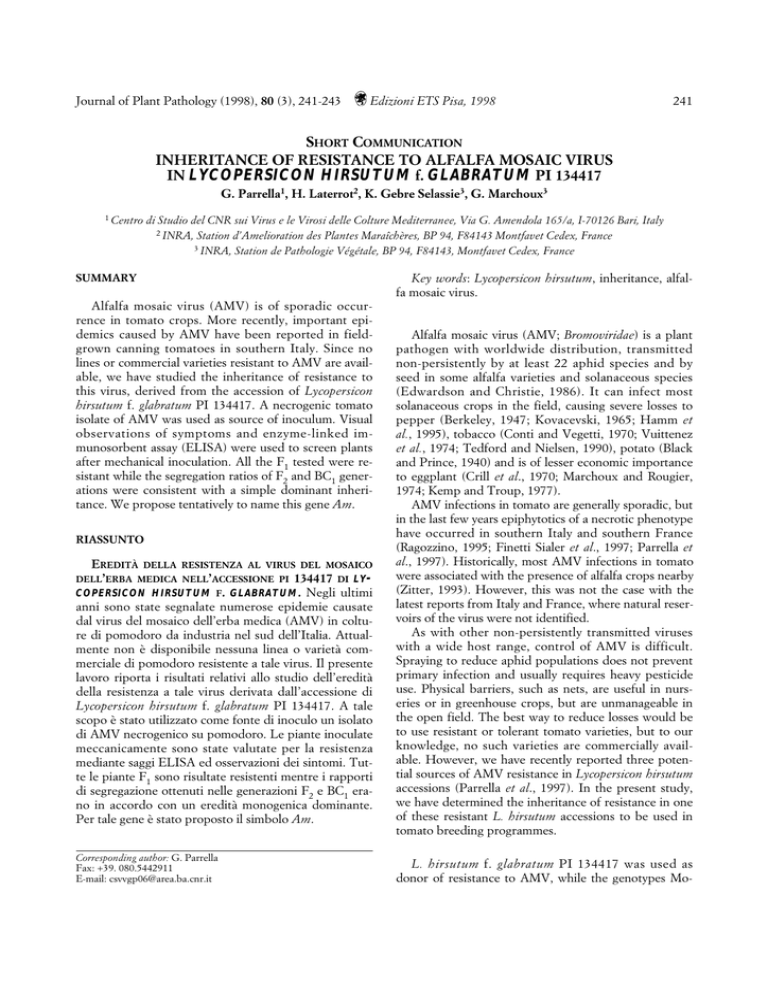
Journal of Plant Pathology (1998), 80 (3), 241-243
Edizioni ETS Pisa, 1998
241
SHORT COMMUNICATION
INHERITANCE OF RESISTANCE TO ALFALFA MOSAIC VIRUS
IN LYCOPERSICON HIRSUTUM f. GLABRATUM PI 134417
G. Parrella1, H. Laterrot2, K. Gebre Selassie3, G. Marchoux3
1 Centro
di Studio del CNR sui Virus e le Virosi delle Colture Mediterranee, Via G. Amendola 165/a, I-70126 Bari, Italy
2 INRA, Station d’Amelioration des Plantes Maraîchères, BP 94, F84143 Montfavet Cedex, France
3 INRA, Station de Pathologie Végétale, BP 94, F84143, Montfavet Cedex, France
SUMMARY
Key words: Lycopersicon hirsutum, inheritance, alfalfa mosaic virus.
Alfalfa mosaic virus (AMV) is of sporadic occurrence in tomato crops. More recently, important epidemics caused by AMV have been reported in fieldgrown canning tomatoes in southern Italy. Since no
lines or commercial varieties resistant to AMV are available, we have studied the inheritance of resistance to
this virus, derived from the accession of Lycopersicon
hirsutum f. glabratum PI 134417. A necrogenic tomato
isolate of AMV was used as source of inoculum. Visual
observations of symptoms and enzyme-linked immunosorbent assay (ELISA) were used to screen plants
after mechanical inoculation. All the F1 tested were resistant while the segregation ratios of F2 and BC1 generations were consistent with a simple dominant inheritance. We propose tentatively to name this gene Am.
RIASSUNTO
EREDITÀ
DELLA RESISTENZA AL VIRUS DEL MOSAICO
134417 DI LYCOPERSICON HIRSUTUM F. GLABRATUM. Negli ultimi
DELL’ERBA MEDICA NELL’ACCESSIONE PI
anni sono state segnalate numerose epidemie causate
dal virus del mosaico dell’erba medica (AMV) in colture di pomodoro da industria nel sud dell’Italia. Attualmente non è disponibile nessuna linea o varietà commerciale di pomodoro resistente a tale virus. Il presente
lavoro riporta i risultati relativi allo studio dell’eredità
della resistenza a tale virus derivata dall’accessione di
Lycopersicon hirsutum f. glabratum PI 134417. A tale
scopo è stato utilizzato come fonte di inoculo un isolato
di AMV necrogenico su pomodoro. Le piante inoculate
meccanicamente sono state valutate per la resistenza
mediante saggi ELISA ed osservazioni dei sintomi. Tutte le piante F1 sono risultate resistenti mentre i rapporti
di segregazione ottenuti nelle generazioni F2 e BC1 erano in accordo con un eredità monogenica dominante.
Per tale gene è stato proposto il simbolo Am.
Corresponding author: G. Parrella
Fax: +39. 080.5442911
E-mail: [email protected]
Alfalfa mosaic virus (AMV; Bromoviridae) is a plant
pathogen with worldwide distribution, transmitted
non-persistently by at least 22 aphid species and by
seed in some alfalfa varieties and solanaceous species
(Edwardson and Christie, 1986). It can infect most
solanaceous crops in the field, causing severe losses to
pepper (Berkeley, 1947; Kovacevski, 1965; Hamm et
al., 1995), tobacco (Conti and Vegetti, 1970; Vuittenez
et al., 1974; Tedford and Nielsen, 1990), potato (Black
and Prince, 1940) and is of lesser economic importance
to eggplant (Crill et al., 1970; Marchoux and Rougier,
1974; Kemp and Troup, 1977).
AMV infections in tomato are generally sporadic, but
in the last few years epiphytotics of a necrotic phenotype
have occurred in southern Italy and southern France
(Ragozzino, 1995; Finetti Sialer et al., 1997; Parrella et
al., 1997). Historically, most AMV infections in tomato
were associated with the presence of alfalfa crops nearby
(Zitter, 1993). However, this was not the case with the
latest reports from Italy and France, where natural reservoirs of the virus were not identified.
As with other non-persistently transmitted viruses
with a wide host range, control of AMV is difficult.
Spraying to reduce aphid populations does not prevent
primary infection and usually requires heavy pesticide
use. Physical barriers, such as nets, are useful in nurseries or in greenhouse crops, but are unmanageable in
the open field. The best way to reduce losses would be
to use resistant or tolerant tomato varieties, but to our
knowledge, no such varieties are commercially available. However, we have recently reported three potential sources of AMV resistance in Lycopersicon hirsutum
accessions (Parrella et al., 1997). In the present study,
we have determined the inheritance of resistance in one
of these resistant L. hirsutum accessions to be used in
tomato breeding programmes.
L. hirsutum f. glabratum PI 134417 was used as
donor of resistance to AMV, while the genotypes Mo-
242
Resistance to AMV in Lycopersicon hirsutum
Journal of Plant Pathology (1998), 80 (3), 241-243
mor of L. esculentum and PI 247087 Australia of L. hirsutum f. glabratum were used as susceptible controls
(Parrella et al., 1997) and were crossed with PI 134417.
For the inheritance study, the following generations
were used: F1 (Momor x PI 134417), F1 (PI 134417 x
PI 247087), F1 (PI 247087 x PI 134417), F2 progenies
(Momor x PI 134417) and (PI 134417 x PI 247087) obtained by F1 intercrossing, and the first generation of
backcross BC1 PI 247087 x (PI 134417 x PI 247087).
Seedlings were transplanted at the cotyledon stage to
10 cm diameter pots with peat bog-moss as substrate
and watered weekly with a nutrient solution. All plants
were grown in an insect-proof greenhouse (22-26°C
and 70-80% humidity) under natural lighting.
The AMV isolate LYH-1 (Parrella et al., 1997) was
used as source of inoculum, and was maintained and
multiplied in Nicotiana tabacum cv. ‘Xanthi’ n.c. Inoculum was prepared by grinding 1 g of young tobacco
leaves in 4 ml of 0.03 M Na2HPO4 buffer containing
0.2% sodium diethyldithiocarbamate. Before inoculation, 75 mg ml-1 of carborundum and activated charcoal
were added to the sap extract (Marrou, 1967). The slurry was used to inoculate cotyledons and the first two
true leaves of 16-day-old seedlings.
Symptoms were observed from one day up to one
month after inoculation. Samples from uninoculated
leaves were tested 15 and 30 days after inoculation by
using DAS-ELISA as described by Clark and Adams
(1977). Plant extracts were prepared by grinding 1 g of
leaves in 4 ml of inoculation buffer with a leaf press.
An antiserum (kindly supplied by H. Lot, INRA,
Avignon) to an isolate of AMV from lettuce was used.
Plates were read with a Tirtertek Multiskan Plus Photometer at 405 nm 1 h after addition of the substrate.
Samples were considered positive when the absorbance
value was more than twice the mean of the healthy controls.
L. hirsutum f. glabratum PI 134417 showed no reaction to infection and no symptoms for at least 1 month
after inoculation both in inoculated and uninoculated
leaves, and no virus was detected by ELISA 15 and 30
days after inoculation in the same tissues (Table 1). The
susceptible controls, Momor and the hirsutum accession PI 247087 Australia, reacted with prominent local
and systemic necrosis few days after inoculation, followed by death of the plant.
Plants of the three F 1 Momor x PI 134417, PI
134417 x PI 247087 and PI 247087 x PI 134417, behaved like the resistant parent and showed no symptoms in inoculated and uninoculated leaves, which were
also negative when checked by ELISA 15 and 30 days
after inoculation. The resistance was therefore dominant regardless of the resistant parent.
F 2 plants deriving from the crosses Momor x PI
134417 and PI 134417 x PI 247087 segregated in the
ratio 3 resistant to 1 susceptible. Further confirmation
of the presence of a single dominant gene was obtained
Table 1. Reaction of parents Momor (susceptible), PI 134417 (resistant), PI 247087 (susceptible) and segregating generations to
inoculation with AMV isolate LYH-1, based on symptoms development and ELISA results.
Genotypes
no. plants
Symptoms
S/R
espected
ratio
ELISA
χ2
P
+/–
Momor (P1)
30
30a/0
–
PI 134417 (P2)
30
0/30
0/30
PI 247087 (P3)
30
30a/0
–
F1 (P1 x P2)
10
0/30
0/30
F1 (P2 x P3)
30
0/30
0/30
F1 (P3 x P2)
30
0/30
0/30
espected
ratio
χ2
P
BC1 (P2 x P3) x P3
100
51/49
1:1
0.04
0.90-0.75
51/49
1:1
0.04
0.90-0.75
F2 (P1 x P2)
159
32a/127
1:3
2.56
0.25-0.10
–/127
1:3
2.56
0.25-0.10
F2 (P2 x P3)
149
33/116
1:3
0.65
0.50-0.25
33/116
1:3
0.65
0.50-0.25
S/R: no. susceptible plants/no. resistant plants
+/–: no. of plants positive/no. of plants negative
a: dead plants
Journal of Plant Pathology (1998), 80 (3), 241-243
from the backcross population PI 247087 x (PI
1344117 x PI 247087) which segregated in the ratio 1
resistant to 1 susceptible. This was considered as evidence that the genetic factor in L. hirsutum f. glabratum
PI 134417 is a single dominant gene, to which the symbol Am has been tentatively assigned.
Am is the first gene identified conferring resistance
to AMV in tomato. As the gene is simply inherited, it
can be easily introgressed using backcrossing or pedigree breeding. No differences were found in segregating ratios in intra- and interspecific crosses. The resistance of L. hirsutum PI 134417 was efficient against
several virus isolates from different geographic areas in
mechanical inoculation tests (data not shown). Further
analysis could give more information about the possibility of using this resistance for breeding purposes by
testing advance breeding lines in the field.
Recently AMV has been reported as potentially very
dangerous in tomato crops in the south of Italy, mainly
due to the appearance of a strain inducing necrosis on
leaves and fruits (Ragozzino, 1995; Finetti Sialer et al.,
1997). The resistance to AMV reported in this study
could provide a useful means of reducing such losses.
ACKNOWLEDGEMENTS
The authors thank Prof. G.P. Martelli and Prof. D.
Gallitelli for critical reading of the manuscript.
Parrella et al.
243
Edwardson J.R., Christie R.G., 1986. Alfalfa mosaic virus. In:
Viruses infecting forages and legumes. Vol. I, monograph
no. 14. Agricultural Experiment Station, Institute of food
and Agricultural Science, University of Florida.
Finetti Sialer M., Di Franco A., Papanice M.A., Gallitelli D.,
1997. Tomato necrotic yellows induced by a novel strain of
alfalfa mosaic virus. Journal of Plant Pathology 2: 115-120.
Hamm P.B., Jaeger J.R., Mac Donald L., 1995. Virus disease
of pepper in northeast Oregon. Plant Disease Reporter 79:
968.
Kemp W.G., Troup P.A., 1977. Alfalfa mosaic virus occuring
naturally on eggplant in Ontario. Plant Disease Reporter 5:
393-396.
Kovacevski I.C., 1965. Lyutsernovo-mosaichniyat virus y
Bulgariya. Rasteniev. Nauki 2, Reviews of Applied Mycology 45: 768. Abstract.
Marchoux G., Rougier J., 1974. Virus de la mosaique de la
luzerne: isolement à partir du lavandin (Lavandula hybrida
Rev.) et de l’aubergine (Solanum melongena L.). Annales
de Phytopathologie 8: 191-196.
Marrou J., 1967. Amélioration des méthodes de transmission
mécanique des virus par adsorption des inhibiteurs d’infection sur charbon végétal. Comptes Rendus de l’Academie d’Agriculture de France 53: 972-981.
Parrella G., Laterrot H., Marchoux G., Gebre-Selassie K.,
1997. Screening Lycopersicon accessions for resistance to
alfalfa mosaic virus. Journal of Genetics and Breeding 51:
75-78.
Ragozzino A., 1995. Nuove acquisizioni sulle principali malattie virali del pomodoro. Petria 5 (Supplement 1): 25-38.
REFERENCES
Berkeley, G.H., 1947. A strain of the alfalfa mosaic virus on
pepper in Ontario. Phytopathology 37: 781-789.
Tedford E.C., Nielsen M.T., 1990. Response of Burley tobacco cultivars and certain Nicotiana spp. to alfalfa mosaic infection. Plant Disease 12: 956-958.
Black L.M., Prince W.C., 1940. The relationship between
viruses of potato calico and alfalfa mosaic. Phytopathology
30: 444-447.
Vuittenez A., Kuszala J., Puts C., 1974. Le virus de la mosaique de la luzerne associé a une maladie nécrotique des
feuilles du tabac dans les cultures en Alsace. Annales de
Phytopathologie 6: 113-128.
Conti G.G., Vegetti G., 1970. Caratteristiche di un ceppo
del virus del mosaico dell’erba medica isolato da tabacco.
Rivista di Patologia Vegetale 6: 37-49.
Zitter T.A., 1993. Alfalfa Mosaic. In: Compendium of tomato
diseases, pp. 31-35. APS press, The American Phytopathological Society.
Crill P., Hagedorn D.J., Hanson E.W., 1970. Alfalfa mosaic
the disease and its virus incitant. The University of Wisconsin, Research Bulletin no. 280.
Received 26 June 1998
Accepted 17 September 1998

